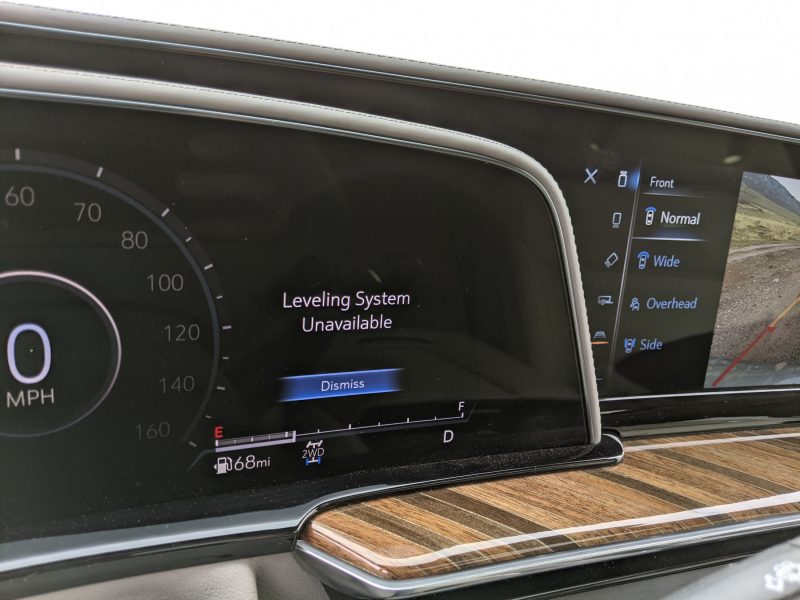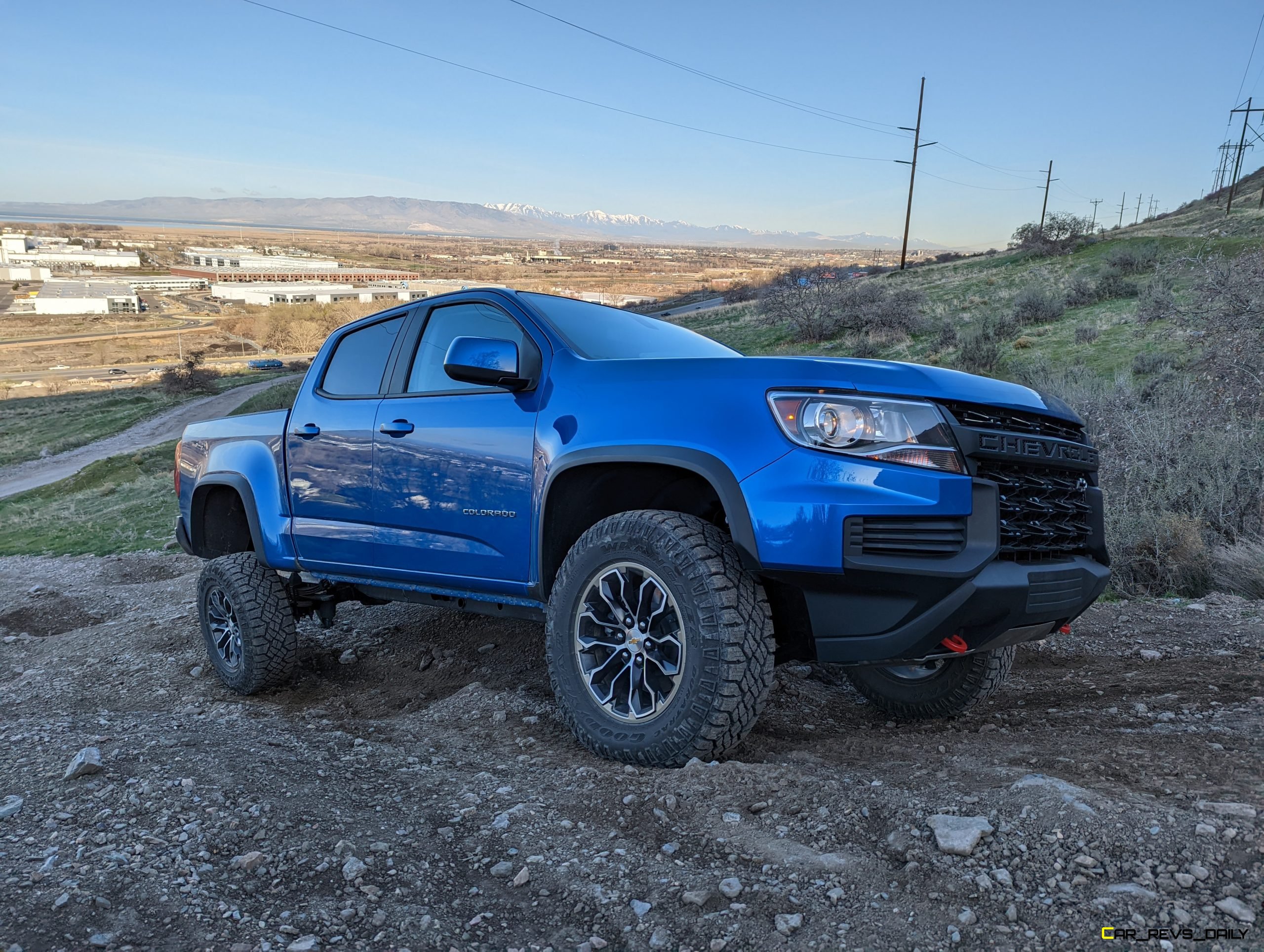Cadillac Escalade Platinum
GM has updated their large SUV platforms which include the Tahoe/Suburban, Yukon/XL, and Escalade/ESV. We had a chance to tow two different travel trailers a total of 500 miles with the Escalade Premium. This was done on a road trip to Capitol Reef National Park in Central Utah. The Escalade Platinum model we tested was equipped with the 6.2-liter V8.
Specs
On GM pickup trucks and large SUVs, they provide a sticker, usually on the B pillar behind the driver’s door, with towing information. All manufacturers should take note, as this is much better information than can be found in the owner’s manual or online. The sticker is easy to find and lists the specific towing and payload capacities for the vehicle it is placed on, not some general number.
In the case of our 4wd 2021 Escalade Platinum, the payload capacity was 1,482 pounds and the towing capacity was 7,500 pounds. 2wd Escalades can have up to 8,500 pounds of towing capacity when properly equipped.
The owner’s manual states that a weight distribution hitch is required for trailers over 6,000 pounds. We would recommend using a weight distribution hitch whenever towing a travel trailer or cargo trailer with a high profile.
Technology
Cadillac actually includes a lot of towing technology in the Escalade. Our test model had a factory installed trailer brake controller, light checks, trailer TPMS, trailering assist guidelines, auxiliary trailer camera and a rear vision trailer camera.
The light checks allow the driver to get out and check the lights while the Escalade illuminates the different lights one by one.
Noteworthy for towing, is the suspension setup. The 4-wheel independent air suspension keeps the Escalade level even when hauling or towing heavy loads. The benefit of this is that as weight is added to the vehicle the spring rate increases. This in turn increases the stability of the tow vehicle. Add in the magnetic dampers which can increase the damping force under load and you end up with a very stable towing platform.
Towing with an Escalade
5,000-Pound Travel Trailer
Over 400 of the 500 miles we towed was done pulling a 5,000-pound travel trailer without weight distribution. This included roughly 50 miles on city streets, about 150 miles of freeway and 200 miles of two-lane highway.
For city driving the Escalade handled the load just fine. The steering was very direct without floating and the torque from the V8 was good off the line. As mentioned later, a more towing oriented final drive ratio would be helpful, but we didn’t feel like we were lacking power.
On the freeway, bumps and expansion joints were well mitigated by the air suspension and magnetic dampers. However, we could feel the trailer pushing the Escalade when there were higher crosswinds or when passing big rigs. Nothing was too scary, and we traveled at 70 mph (speed limit is 80 mph) comfortably for the whole freeway section.
The final stretch to get to Capitol Reef requires driving two-lane highways with 65 mph speed limits. There were sections of higher winds causing some trailer sway, but nothing unsettling. Even oncoming big rigs didn’t upset the vehicle. The Escalade was always at ease and all the systems worked together for a wonderful towing experience.
8,000-Pound Travel Trailer
The second trailer we towed as an 8,000-pound travel trailer with weight distribution. This trailer was towed about 100 miles in and around Capitol Reef. Yes, we know 8,000-pounds is over the maximum rating for our vehicle, but it was the closest thing we had to the maximum for this vehicle, and it towed well. We recommend always staying within the manufacturers recommended ratings.
For this trailer we used an Equal-i-zer weight distribution hitch. Having the weight distribution hitch attached made a significant difference in the stability of the Escalade. No longer did we feel the trailer pushing the Escalade around, even in sections with high crosswinds. We know there are other factors involved when comparing two different trailers, but the hitch played a large roll in adding stability.
Surprising Pros While Towing
Two things really surprised us while towing with the Escalade. The first, is how well the vehicle handles towing overall. We had cross wind gusts of 35-40 mph and while we felt the trailer pushing the Escalade around a little, we never felt uneasy. Of course, power wasn’t an issue with 460 pound-feet of torque, and the dynamic suspension kept control over undulations and potholes that would upset other vehicles.
The second is that the 10-speed transmission remained cool the entire time. While towing in other Ford and GM products with 10-speed transmissions the temperatures seemed to almost always be above 200°F. However, while towing in the Escalade the transmission stayed around 175°F and this as one of the longest towing tests we’ve done.
Cons While Towing
We only ran into one issue while towing. A few minutes of driving after connecting the Equal-i-zer hitch to the 8,000-pound trailer, the air suspension shut down. A warning popped up on the screen saying that it may be unsafe to drive. We pulled over and had a look. It was obvious that the suspension was too low to continue driving.
Luckily, we were in an area with cell phone coverage and were able to search in the internet for solutions. It turns out many people have had this problem with their Tahoe/Yukon/Escalade when equipped with the air suspension. The solution was to disconnect the battery for about 5 minutes, reconnect it and start the engine. It worked for us. Just as a precaution we disabled the entry/exit mode to prevent the Escalade from lowering when placed in park. The issue never returned.

One major downside towing with the Escalade is the 3.23 final drive ratio. Having a 10-speed automatic helps mitigate the lack of a more towing oriented axle ratio, but fuel mileage still suffered greatly. We averaged 7.5 mpg over our entire trip, which is the worst we’ve ever had pulling this trailer. While the 3.23 improves fuel efficiency when not towing it likely hurts efficiency when under load. The engine must work harder with the 3.23 axle ratio than it would if it had a higher numerical ratio of 3.55, 3.73, or 3.92. It would be nice for those who tow often to have the option of a better final drive ratio.
Conclusion
If you’re in the market for a luxury vehicle that can tow a heavy boat, travel trailer, or other toys, the Escalade might be your best option. It has a stout, body on frame design with plenty of towing features. Add in the power and torque of the 6.2-liter V8 and trick suspension and you won’t find a more comfortable towing experience in any other SUV.

Matthew Barnes is an experienced towing expert. He works as a mechanical engineer and his day job involves testing a variety of vehicles while towing trailers of all types and sizes. Matt shares his knowledge by writing for automotive news outlets in the evenings. When he’s not working he can be found spending time in the great outdoors with his family. He enjoys camping, hiking, canyoneering, and backpacking. Whenever possible he spends time riding in or on any power sports vehicle he can find and claims he can drive anything with a motor, which probably isn’t true.
Matt lives in the Utah mountains and often posts cool off-roading videos to his Instagram and YouTube channel.
































